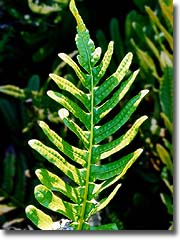Polypodium californicum;
California Polypody
Polypodiaceae (Polypody Family)
Fronds: Up to 15 inches long; in small clusters.
Pinnae: Smooth surfaced, rounded tips.
Sori: In rows along underside of pinnae.
Location: Common along most trails, especially on bluffs.
Status: Common - Native.

Polypodium californicum
450x600
JPEG - 52K
Further description & Comment: 4 to 20 inches tall. Another of the "friendly" ferns, cute little Polypodies can be found sticking out of crevices and popping up from underbrush in most areas of the mountain. Colonies range in size from 2 or 3 small fronds to hundreds.
These images are from the crowd that live up by North Peak - the one below right shows the unovered sori on the bottom of the pinnae.